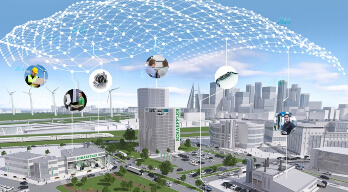
Mobility for tomorrow: Digitalization is a key element of Schaeffler's strategic focus.
In the coming years, the automotive and industrial supplier, Schaeffler, wants to recruit up to 600 experts across the world to work on digital solutions for tomorrow's mobility. The planned new positions are part of a digitalization offensive the company started last year. A central pillar of the strategy is the development of intelligent products. At CES 2017, Schaeffler is showing how visions of automated driving, electrification and networking can be turned into reality.
Automobiles are part of the Internet of Things where machines share data with each other to provide better solutions for people. "This development is an enormous opportunity for Schaeffler," explains Gerhard Baum, Chief Digital Officer for the company. "Our components and systems are needed precisely where stresses, forces and torques occur: In the powertrain and in the chassis." If these components, such as the bearings used in the chassis, are fitted with sensors which measure torques, forces, vibrations and temperatures, it is possible to capture vital information on the condition and use of both the module and the entire system.
Schaeffler has already laid the technical foundations for the integration of these sensors and actuators into components by developing the Sensotect bearing which collects measurements using nanostructured coatings. "The important thing here is not just that we are capturing data but that we are also able to interpret them correctly and convert them into actions," emphasizes Mr. Baum. "Schaeffler has the necessary expertise in this field, not just in the automotive industry, but in other sectors as well, such as the wind power industry."
Strategic partnership with IBM
Adding sensors to complex machines and automobiles generates volumes of data which have to be interpreted and converted into added value. "We are currently creating the conditions for this process," says Mr. Baum. An important milestone was passed in October 2016 with the agreement of a strategic partnership with IBM. It is not just the cloud or “Watson” technology which is now available to Schaeffler, but a partner from the IT sector with whom it is possible to implement both new and proven methodologies. "Significant advances are currently being made in the development of machine learning and artificial intelligence," explains Mr. Baum. We will make these technologies available to our engineers so that we can learn more quickly. Over the next few years, Schaeffler is planning to take on a large number of experts in the fields of data architecture, data analysis, design thinking, app development and business modeling in order to develop innovative applications for the automotive industry and other sectors.
Making smart products smarter
New technologies will allow Schaeffler to extend the functionality of components and systems through data generation and preparation. Real-time analysis and cognitive systems will convert the generated data into valuable information and recommended actions.
Schaeffler is showing an active mechatronic roll control system at CES. It keeps the vehicle's structure horizontal when driving round curves and irrespective of the condition of the road surface. In this mechatronic system from Schaeffler, which is now in volume production, a particularly efficient electric actuator compensates the rolling motion of the vehicle for the first time. The next generation of this actuator will have the potential to also act as a sensor which will capture 3D data on the condition of the road. If combined with accurate GPS and intelligent evaluation systems, it would be possible to produce real-time information which could be useful to vehicles following on behind or to the infrastructure operator.
Energy supply is becoming increasingly important in the electrification of road traffic. A further pilot project will ensure that wind turbines can operate more efficiently. Schaeffler is already offering solutions which can check that wind turbine components are functioning correctly. In the future, it will be possible to calculate the remaining operating life of each individual component with the aid of learning algorithms, so that each turbine can have its own optimized operating strategy. This will reduce unexpected failures to a minimum.
This new digital infrastructure and initial set of applications are just a part of Schaeffler's digitalization offensive. "We are also digitizing processes in our own production facilities as well as in many other areas of the company," says Mr. Baum. "As we are combining our systems expertise from the automotive and engineering industries with digitalization, we are a very attractive employer for data analysts, data architects, design thinking experts and app developers."

 Industry News
Industry News